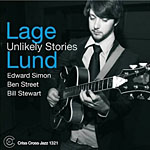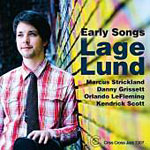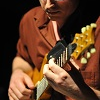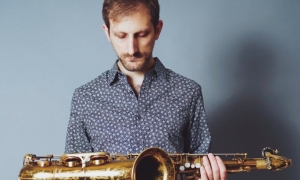Home » Jazz Articles » Interview » Lage Lund: Looking Forward
Lage Lund: Looking Forward
 Growing up in Norway, a young Lage Lund dreamt of moving to New York, though not to play guitar, but to break dance in the NY subway system. Luckily for jazz guitar fans, this dream was never realized. Instead, Lund picked up the guitar at the age of thirteen and hasn't looked back. Since then, he has recorded on numerous records as a sideman, released three albums under his own name, and won the most prestigious jazz competition in the world, 2005's Thelonious Monk Guitar Competition.
Growing up in Norway, a young Lage Lund dreamt of moving to New York, though not to play guitar, but to break dance in the NY subway system. Luckily for jazz guitar fans, this dream was never realized. Instead, Lund picked up the guitar at the age of thirteen and hasn't looked back. Since then, he has recorded on numerous records as a sideman, released three albums under his own name, and won the most prestigious jazz competition in the world, 2005's Thelonious Monk Guitar Competition.Aside from his impressive résumé as a jazz player, Lund has also excelled as a student of the art form. After receiving a Fulbright award in 2002, Lund enrolled in Julliard's full-scholarship jazz degree, becoming the first electric guitarist ever to be admitted to that prestigious program. Since moving to the Big Apple, Lund has performed at some of the city's top jazz clubs, including the 55 Bar, Smalls and the Jazz Gallery, as well as gracing the stages of the Lincoln Center and the Kennedy Center alongside some of the biggest names in jazz, including Wynton Marsalis, Ingrid Jensen and Seamus Blake.
Always on the move with his music, Lund released his second record for Criss Cross in 2010. Unlikely Stories features the all-star lineup of drummer Bill Stewart, bassist Ben Street and pianist Edward Simon. Recorded in a short, six-hour session, Unlikely Stories has garnered considerable attention from critics and fans alike, providing yet more momentum to an already fertile career for this young jazz guitar lion.
All About Jazz: Unlikely Stories was released on the Criss Cross label. It seems that, when jazz artists record with a label like Criss, it's done fairly quickly, as far as time spent in the studio. It might only be an afternoon or maybe a day in the studio and the album is finished. How did the recording process work out for you this time around?
Lage Lund: Usually the way it works with Criss Cross is we have about six hours to do the record. Everything moves fairly quickly. There's not a lot of endless take-after-take situations, but I prefer to do it that way anyway. It's not a lot of time, and certainly it's nice to have two days to record, because you never know what's going to happen on any given day. Two days would be nice but, on the other hand, I don't mind having to keep things moving; not getting bogged down with one tune.
I find that if I spend too much time listening back to tracks they start to change. We might adjust things that we wouldn't have, if we didn't spend so much time listening back to the track—for better or for worse. We can also get accustomed to playing in the studio, as opposed to playing as if we're on a gig, which can produce different results as well.
AAJ: Because you only had six hours in the studio, and you recorded all original material, did you rehearse a lot before you went in to record the album?
LL: No, not really. For this record we only had one real rehearsal with the whole band. It was a dream band for me, having those guys together, but it was difficult to get these guys all in one room because of their schedules. I was happy that we managed to get that one day together. We had the day in the studio and a rehearsal the day before, which was more than I had expected. Ben and I had played a lot of that music before, mostly on gigs. Bill had also done some gigs where we played some of those tunes, but Ed had never played any of those tunes.
They all did an amazing job. Not just playing each tune correctly, but doing something with them almost instantly. They didn't just plough through it. They really got into each tune. There were some things that I might've done differently if we had more rehearsals, but it's really nice to get someone's first impression on a tune, when it's still new and fresh to them. I think that can be interesting to listen for sometimes as well.
 AAJ: Now that you've released albums with a label, Criss Cross, and have self-produced an album, which do you prefer?
AAJ: Now that you've released albums with a label, Criss Cross, and have self-produced an album, which do you prefer? LL: I think they both have their pros and cons. Obviously, the great thing about working with a label is that everything is paid for. The studio is covered, the guys get paid. You don't have to come up with a chunk of money to cover that, which could be tricky to make happen. However, I think if you're able to do that it's a great thing. For one, you have complete control over what you've recorded once it's done. All the revenue would go back to you, so it's a worthwhile thing, especially today when being on a label doesn't mean as much as it used to. Labels used to be very important because they'd take care of distribution. But, with more people buying their music online, distribution is becoming less important, as far as getting a record onto store shelves is concerned.
 AAJ: The lineup on the record features a guitar trio plus piano, which seems to be a popular format for modern jazz guitarists these days. Is this the lineup that you prefer to use right now, and if so, what makes it appealing to you as a writer and performer?
AAJ: The lineup on the record features a guitar trio plus piano, which seems to be a popular format for modern jazz guitarists these days. Is this the lineup that you prefer to use right now, and if so, what makes it appealing to you as a writer and performer?LL: A lot of the gigs that I do are as a sideman, and for most of those I'm the only chordal instrument. I'm used to working without a piano and functioning as a piano in an ensemble. I really like it. I love accompanying horn players in a trio. I love the freedom of that. But, I also really love playing with pianists, at least the ones that listen and can work with a guitar in the group.
One of the reasons I ended up having piano on this session was that I write most of my material on the piano. I don't write much on the guitar, mostly at the keyboard. So most of the sounds I have when I'm working on a new tune come from that instrument. Also, I always wanted to work with Ed and this was a good opportunity to do that. I don't think I have a specific preference for a trio, quartet, quintet or whatever. For me, it's more of who I'm playing with than what instrument they're playing that matters more.
AAJ: Do you have to change your playing style when working with a pianist?
LL: I think it changes in the same way I would change my playing when working with different drummers or bass players. It's more a matter of changing things so that they work better with the group as a whole. When I'm the only chordal instrument and I'm accompanying myself, my harmony becomes freer. I'll take more, not chances, but I'll move the harmony around here and there as I'm playing, because I can. With piano, a lot of times their voicings will lead me to a different space. Where I'm more engaged in a conversation with them, rather than moving the harmony around as much as I would in a trio setting.
AAJ: There's a picture of you on the cover with an archtop guitar. Is that the guitar you used for the recording?
LL: That's actually not the guitar I used. The guitar I used on the record was a Sadowsky Jim Hall model. They took some pictures with me and that guitar, but the label didn't think they turned out well, so they used an older picture that looked better.
AAJ: Is the Sadowsky your guitar of choice right now?
LL: Yeah. It's kind of like a [Gibson] 175 and was based on the D'Aquisto that Jim Hall used to play. It's a great guitar. I've had it for a little over a year now and it's very versatile and even. It works very well in a quartet, where I need to cut through as the main melodic voice, or in a trio, where I need that bigger acoustic range for voicings and the like.
AAJ: A lot of modern guys seem to be using older Ibanez Artists, Fender Telecasters or even Fender Stratocasters. Do you feel that by using an archtop it helps differentiate you a bit from other players, at least as far as your tone is concerned?
LL: I've always been drawn to a more acoustic sound in music. I think that's why I tend to gravitate more towards acoustic guitar. I like to feel that connection to the direct production of the sound, which you can only get with an acoustic instrument. I like tube amps and I I'll use different pedals, but I think what I'm going for is the root of the tone, like you would get with a nylon- string guitar. If I used a Tele or Strat I don't think I would have that connection. It's just my personal preference, but I like that rounder, fatter tone that I get with those types of acoustic instruments. But, that can change someday too; who knows?
 AAJ: What kind of amps are you running through?
AAJ: What kind of amps are you running through?LL: I'm always experimenting with amps, and I've gone through lots of different models. I still really like older Polytones, they're great amps. I've also gotten into the sound quality I can get out of a good tube amp. Lately I've been using an '81 Fender Concert that I modified to give me some of those Polytone qualities, along with that sparkle you get from a tube amp. On the record I was using a Music Man, but I'm still experimenting with that part of my sound. I used to only play solid state amps, but now I'm checking out more tube amps, so that part of my playing is evolving right now.
AAJ: You travel a lot with your group and as a sideman. Do you find that it's easier to find say a Fender amp when you're overseas than a Polytone, which might be harder to get?
LL: Absolutely. You can always depend on finding a Fender Twin or Deluxe no matter where you go. It might not be great, but at least you can get used to it as it'll be consistent. So that's part of it. The Jim Hall is more adaptable to that kind of situation, more so than the larger archtop I used to use. I really like the Sadowsky for that reason, among others. It's a great guitar for bringing into the studio and for taking with me when I hit the road.
Selected Discography
Lage Lund, Unlikely Stories (Criss Cross, 2010)
Will Vinson, The World Through My Shoes (19/8 Records, 2010)
Seamus Blake, Bellweather (Criss Cross, 2009)
Jimmy Green, Mission Statement (Sunnyside, 2009)
Lage Lund, Early Songs (Criss Cross, 2008)
Lage Lund Trio + 1, Standards (Self Published, 2007)
Photo Credits
All Photos: Jimmy Katz
Tags
Lage Lund
Interview
Matthew Warnock
United States
wynton marsalis
Ingrid Jensen
Seamus Blake
Bill Stewart
Ben Street
Edward Simon
Jim Hall
PREVIOUS / NEXT
Support All About Jazz
 All About Jazz has been a pillar of jazz since 1995, championing it as an art form and, more importantly, supporting the musicians who make it. Our enduring commitment has made "AAJ" one of the most culturally important websites of its kind, read by hundreds of thousands of fans, musicians and industry figures every month.
All About Jazz has been a pillar of jazz since 1995, championing it as an art form and, more importantly, supporting the musicians who make it. Our enduring commitment has made "AAJ" one of the most culturally important websites of its kind, read by hundreds of thousands of fans, musicians and industry figures every month.





















